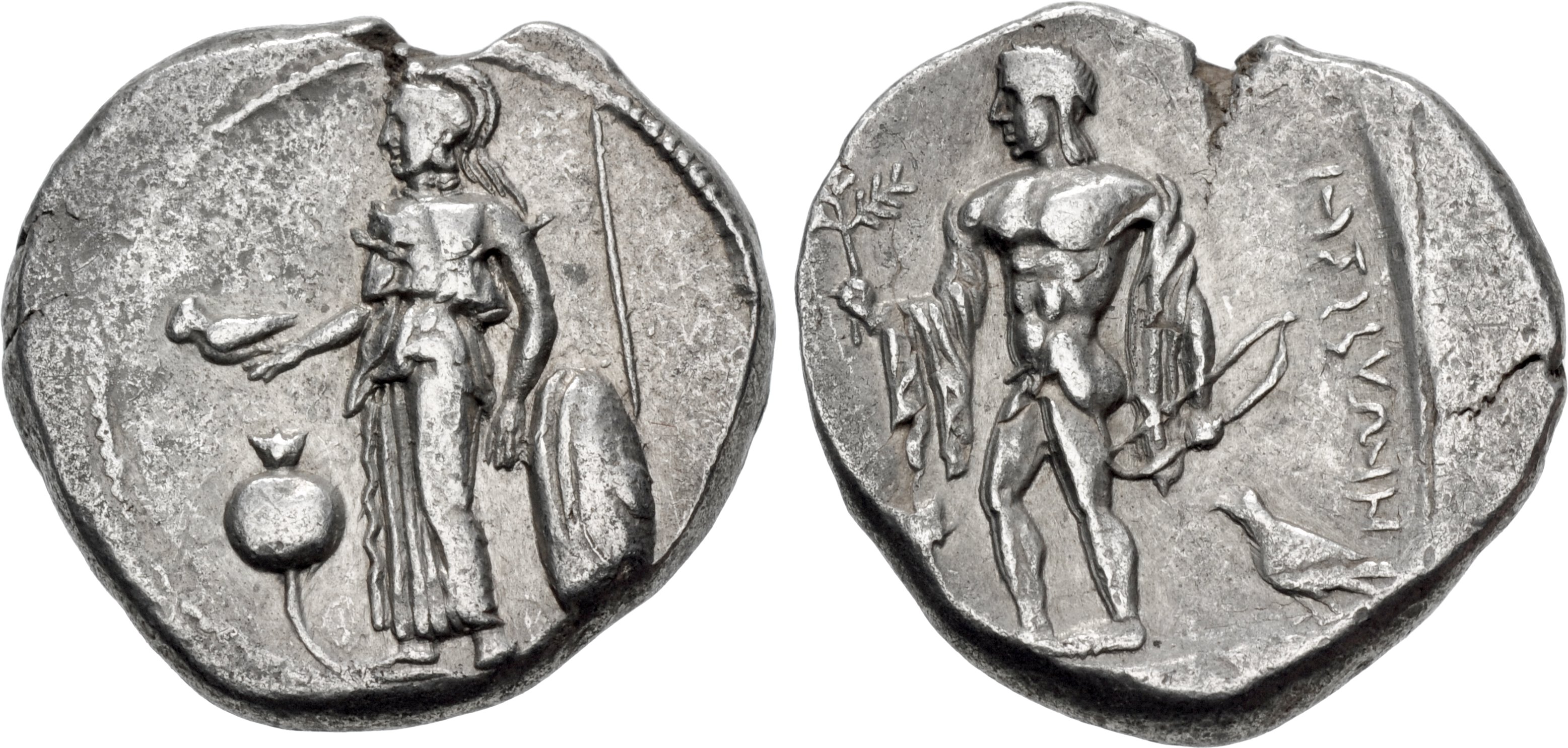2373 - Tarsus (double siglos female head/bearded head) over Side (Athena/Apollo) (Nomos, Obolos, 5, June 2016, 423): Difference between revisions
From SILVER
No edit summary |
No edit summary |
||
| Line 11: | Line 11: | ||
|Mint=Tarsus | |Mint=Tarsus | ||
|Ancient region=Cilicia | |Ancient region=Cilicia | ||
|Authority=Tarkumuwa ( | |Authority=Tarkumuwa (Datames), satrap of Cilicia; Persian Empire | ||
|Date from=378 BCE | |Date from=378 BCE | ||
|Date to=362 BCE | |Date to=362 BCE | ||
Latest revision as of 05:23, 17 August 2023
378 BCE - 362 BCE | TRKMW (in Aramaic characters)
Location/history
| Sale(s)Sale(s) ᵖ: | Nomos, Obolos 5, 26 June 2016, 423 | |
Overstriking coin
Description
| ObverseInscription or printing placed on the obverse.: | Female head facing slightly to left, hair in ampyx, wearing earring and necklace. Dotted border. | ReverseInscription or printing placed on the reverse.: | TRKMW (in Aramaic characters) (Aramaic) Bearded head right, wearing crested Attic helmet, drapery around neck. Border of dots. |
Mint and issuing power
| MintIdentifies the place of manufacture or issue of a numismatic object.: | Tarsus | Ancient regionAncient region. | Cilicia | Modern countryModern country: Turkey | AuthorityIdentifies the issuing power. The authority can be "pretended" when the name or the portrait of X is on the coin but he/she was not the issuing power. It can also be "uncertain" when there is no mention of X on the coin but he/she was the issuing power according to the historical sources: | Tarkumuwa (Datames), satrap of Cilicia, Persian Empire |
Chronology
| FromIdentifies the initial date in a range assigned in a numismatic context. 378 BCE toIdentifies the final date in a range assigned in a numismatic context.. 362 BCE | Classical 480-323 BC |
Physical description
| MetalThe physical material (usually metal) from which an object is made.: Silver |
WeightWeight of the numismatic object (in grams). in grams: 10.410.4 g <br />10,400 mg <br /> | DenominationTerm indicating the value of a numismatic object. Examples: tetradrachm, chalkous, denarius.: double siglos |
AxisDescribes the directional relationship between the obverse and reverse of a numismatic object.: 66 mm <br />0.6 cm <br /> |
| DiameterDescribes diameter of an object (in mm).: 2727 mm <br />2.7 cm <br /> | StandardStandard.: Persian | ||
References
| Coin referenceReference of the Coin: | Callataÿ 2018b, p. 145, n° 36 | Coin series referenceReference to coin series study: | Moysey 19861Moysey 1986, O12, Callataÿ 20002Callataÿ 2000, 109, Callataÿ 2018b3Callataÿ 2018b, p. 145, n° 36 |
| Coin series web referenceCoin series web references: | |||
Overstruck type
Description
| ObverseInscription or printing placed on the obverse.: | Athena standing Athena left, holding Nike in right hand, resting left hand on shield. In field, pomegrenate. Border of dots (visible on obverse). | ReverseInscription or printing placed on the reverse.: | Apollo standing left (visible on reverse). |
Mint and issuing power
| MintIdentifies the place of manufacture or issue of a numismatic object. ᵖ: | Side | Ancient regionAncient region. ᵖ | Pamphylia | Modern countryModern country: Turkey | AuthorityIdentifies the authority in whose name (explicitly or implicitly) a numismatic object was issued. ᵖ: | Persian Empire |
Chronology
| FromIdentifies the initial date in a range assigned in a numismatic context. 400 BCE toIdentifies the final date in a range assigned in a numismatic context.. 380 BCE | Classical 480-323 BC |
Physical description
| DenominationTerm indicating the value of a numismatic object. Examples: tetradrachm, chalkous, denarius. ᵖ: | double siglos |
StandardStandard. ᵖ: | Persian |
References
| Coin type referenceReference to coin series study ᵖ: | SNG France 34SNG France 3, n° 639–640 | ||
| Coin series web reference overstruckCoin series web references overstruck: | |||
Additional data
| Frequency of overstrikesFrequency of overstrikes: | rare and concentrated | Level of confidenceLevel of confidence of the identification: | strong |
| RemarksRemarks: | "Traces of overstriking" | ||

